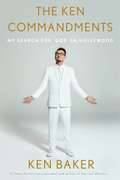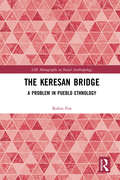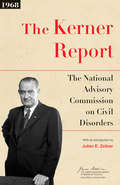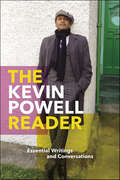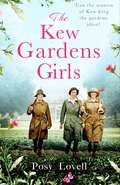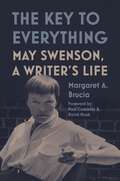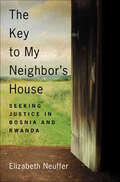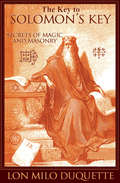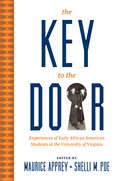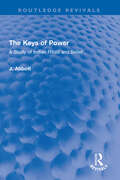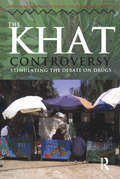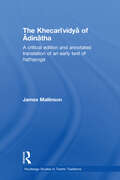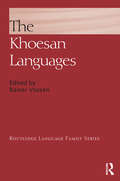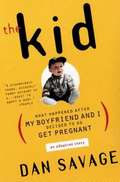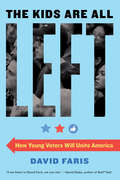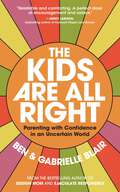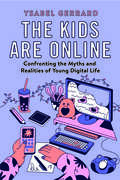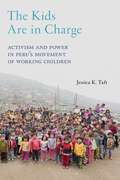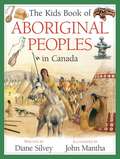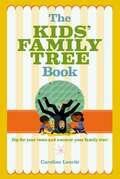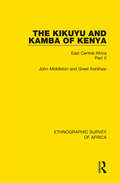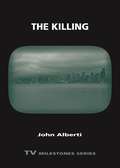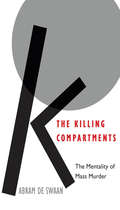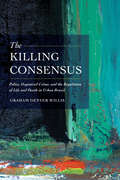- Table View
- List View
The Ken Commandments: My Search for God in Hollywood
by Ken BakerDo the Kardashians really believe in God? An E! News star mixes memoir and investigative journalism in his own rollicking, poignant, and masterful version of A.J. Jacobs’ A Year of Living Biblically, chronicling his own spiritual journey as he investigates the religious lives of the rich and famous in Hollywood. Ken Baker, the popular L.A.-based senior correspondent for E! News and E! Online, has worked in Hollywood for over twenty years—hobnobbing with multimillionaires and interviewing movie, music and TV stars such as George Clooney, Britney Spears, Brad Pitt, Angelina Jolie and Kim Kardashian, day in and day out. In that time, and in the land of fairy tales and double-dealing, Baker had become one of the materialistic, carnal people he never wanted to be, abandoning his Christian heritage and losing his spiritual center in the process. Finding himself alone and confused one day in Vegas, he has an awakening that puts him on a journey to find God, not only in himself, but in the celebrities whose lives intersect with his both professionally and personally. In The Ken Commandments, Ken sets off on an experiment that will bring him closer to the spiritual lives of such diverse luminaries as Deepak Chopra, Tom Cruise, Selena Gomez, Justin Bieber, Joel Osteen and Gwen Stefani and in the process help to reveal the light and dark of Hollywood in new ways. From New Age spirituality, to Bible-based Christianity, to Scientology, to Buddhist retreats, to meditation classes, to Atheism studies, to the mega-church of the nation's top TV preacher, Baker immerses himself in a range of spiritual practices side by side with the celebrity set, revealing a world that is deeper, more questioning and more God-centered than you'd ever imagine.
The Kennedy Assassinations: JFK and Bobby Kennedy—Debunking The Conspiracy Theories
by Mel AytonFew events have been the subject of more conspiracy theories than the assassinations of the two Kennedy brothers. Indeed, a great many people consider that there were other individuals than Lee Harvey Oswald and Sirhan Sirhan involved in both murders. Was a shot fired from Dealey Plaza’s grassy knoll? Why did Jack Ruby shoot Oswald? Was it the CIA, the Soviets, Cuban nationalists or the Mafia that arranged John Kennedy’s assassination? Was Robert Kennedy shot from in front and behind, and who had the most to gain from his death? These are just a few of the questions that have been put forward by a myriad of conspiracy theorists and it is those people and their ideas that Mel Ayton has tackled head-on. Over many years, Mel Ayton has examined all the more substantial conspiracy theories and, through careful analysis of documents and eyewitness statements, he has demolished each one. In each case, Mel Ayton presented the results of his detailed investigations in periodicals as he worked through the various theories. These have now been brought together to provide a comprehensive analysis of all the main theories as to who, how and why the two Kennedy brothers met their deaths in such unusual circumstances. Though wild ideas will continue to be proposed and efforts will still be made to demonstrate that Oswald could not have fired off three shots with great accuracy in the few seconds available to him as the presidential cavalcade passed beneath the window where he crouched, or that there were sinister reasons why three CIA men were allegedly present on the night of Robert Kennedy’s assassination, the harsh reality is that the Kennedy brothers were each killed by lone gunmen. This is an absorbing read, brought up to date with the addition of new material as it has been uncovered. Maybe, just maybe, this book will persuade people that the official accounts of both murders, although flawed, are not cover-ups but simply statements of fact.
The Keresan Bridge: A Problem in Pueblo Ethnology (London School Of Economics Monographs On Social Anthropology Ser. #Vol. 35)
by Robin FoxThis is an unusual excursion into American Indian culture history by a British social anthropologist. It examines theories of the development of different Pueblo social structures, with particular attention to Eggan. From a detailed re-analysis of the evidence and a consideration of material from the Eastern Keresan Pueblo of Cochiti, based on his own fieldwork, Dr Fox concludes that the theory that all Pueblos were derived from a common base is no longer tenable, and that a diversity of origins is more probable. Apart from its contribution to Amerindian studies, the book is of particular interest as an approach to modern culture history by a social anthropologist.
The Kerner Report
by Julian E. Zelizer The National Advisory Commission on Civil DisordersThe Kerner Report is a powerful window into the roots of racism and inequality in the United States. Hailed by Martin Luther King Jr. as a "physician's warning of approaching death, with a prescription for life," this historic study was produced by a presidential commission established by Lyndon Johnson, chaired by former Illinois governor Otto Kerner, and provides a riveting account of the riots that shook 1960s America. The commission pointed to the polarization of American society, white racism, economic inopportunity, and other factors, arguing that only "a compassionate, massive, and sustained" effort could reverse the troubling reality of a racially divided, separate, and unequal society. Conservatives criticized the report as a justification of lawless violence while leftist radicals complained that Kerner didn't go far enough. But for most Americans, this report was an eye-opening account of what was wrong in race relations. Drawing together decades of scholarship showing the widespread and ingrained nature of racism, The Kerner Report provided an important set of arguments about what the nation needs to do to achieve racial justice, one that is familiar in today's climate. Presented here with an introduction by historian Julian Zelizer, The Kerner Report deserves renewed attention in America's continuing struggle to achieve true parity in race relations, income, employment, education, and other critical areas.
The Kevin Powell Reader: Essential Writings and Conversations
by Kevin PowellA hopeful and insightful collection by one of the great voices of our time.“The Kevin Powell Reader is an electric and deeply inspiring selection from Powell’s lifework, spanning the Reagan-Bush years of AIDS and crack epidemics to our current era framed by the COVID-19 pandemic; the tragic killing of George Floyd; the #MeToo movement; and much more.” —EssenceKevin Powell is one of the most prolific and acclaimed American writers, thinkers, activists, and public speakers of the past three decades. His writings are important contributions to our national conversations on race, gender, class, politics, pop culture, celebrity, hip-hop, and the past, present, and future of the United States.The Kevin Powell Reader is an electric and deeply inspiring selection from Powell’s lifework, spanning the Reagan-Bush years of AIDS and crack epidemics to our current era framed by the COVID-19 pandemic; the tragic killing of George Floyd; the #MeToo movement; and much more. In a journey that has produced fifteen books, countless cover stories, hundreds of published pieces, and definitive writings on iconic figures like Stacey Abrams, Dave Chappelle, Kerry Washington, Sidney Poitier, Cicely Tyson, Kobe Bryant, Tupac Shakur, Aretha Franklin, and Kendrick Lamar, Powell is a voice for our times, and a voice that is timeless. This collection also tracks Powell’s personal struggles and his unwavering honesty about himself and the world around him. The Kevin Powell Reader captures twenty-first-century America with hope, insight, and the urgent need to preserve freedom and justice for all people.
The Kew Gardens Girls: An emotional and sweeping historical novel perfect for fans of Kate Morton
by Posy LovellIt's 1916 and England is at war. Desperate to help in whatever way they can, Ivy and Louisa enlist as gardeners at Kew, taking on the jobs of the men who have gone to fight. Under their care, the Gardens begin to flourish - but Ivy and Louisa aren't being treated fairly, and not everyone wants them there. Without women's rights, the pair begin to struggle - but can the support of the Suffragettes help their cause? And when a tragedy overseas affects the people closest to them, can the women of Kew pull together to support themselves and their country through the darkest of times?A heartwarming historical novel about women in wartime, inspired by real life events. Readers love The Kew Gardens Girls:'This was a wonderful book to read, three girls from different backgrounds work at Kew gardens while the men are away at war.' 5 stars
The Key to Everything: May Swenson, A Writer's Life
by Margaret A. BruciaAn intimate portrait of the twentieth-century American poetMay Swenson (1913–1989) was one of the most important and original poets of the twentieth century. The Key to Everything is a biography of this experimental American modernist that draws directly from her unpublished diaries and her letters to friends, family, and colleagues, most notably Elizabeth Bishop. In 1952, Swenson wrote in her diary, &“I want to confirm my life in a narrative—my Lesbianism, the hereditary background of my parents, grandparents, origins in the &‘old country.&’&” Taking up Swenson&’s uncompleted autobiographical plan, Margaret Brucia tells Swenson&’s story as much as possible through her own words.While chronicling the whole of Swenson&’s life, this book focuses on the period from 1936 to 1959, when she came of age artistically and personally in New York City. Against the backdrop of the Great Depression, the Federal Writers&’ Project, Greenwich Village, and the emergence of gay culture, Swenson&’s diaries lay bare her aspirations, fears, joys, and disappointments. Readers see the poet and person emerge, inextricably entwined, as Swenson describes her struggles with poverty, anonymity, and predatory men; her romantic relationships; and the people she met, the books she read, and the work she produced.The most detailed and intimate biography of Swenson to date, The Key to Everything is a unique portrait of a poet who resisted labels throughout her life.
The Key to My Neighbor's House: Seeking Justice in Bosnia and Rwanda
by Elizabeth NeufferInterviewing war criminals and their victims, Neuffer explains, through the voices of people she follows over the course of a decade, how genocide erodes a nation's social and political environment. Her characters' stories and their competing notions of justice-from searching for the bodies of loved ones, to demanding war crime trials, to seeking bloody revenge-convinces readers that crimes against humanity cannot be resolved by simple talk of forgiveness,or through the more common recourse to forgetfulness.
The Key to Solomon's Key: Is This the Lost Symbol of Masonry? (Second Edition)
by James Wasserman Lon Milo Duquette Mark StavishSketching out a fascinating network of historic figures, cults, and Christendom, this book by an occult-studies expert and respected authority on magic and sorcery takes Western spiritual traditions seriously--but examines them with common sense and self-effacing humor. Working backward from the Freemasons to one of their original orders, the 14th-century Knights Templar, the account considers sorcery, heresy, and intrigues; explores the legend that the Knights possessed a powerful secret dangerous to the Church of Rome; and finds an essential clue to the order's practices in their connection to the biblical Solomon, king of Israel in the 10th century BC. This updated edition features new images, chapters on important symbols, and a new preface.
The Key to the Door: Experiences of Early African American Students at the University of Virginia
by Maurice Apprey Shelli M. PoeThe Key to the Door frames and highlights the stories of some of the first black students at the University of Virginia. This inspiring account of resilience and transformation offers a diversity of experiences and perspectives through first-person narratives of black students during the University of Virginia’s era of incremental desegregation. The authors relate what life was like before enrolling, during their time at the University, and after graduation. In addition to these personal accounts, the volume includes a historical overview of African Americans at the University—from its earliest slaves and free black employees, through its first black applicant, student admission, graduate, and faculty appointments, on to its progress and challenges in the twenty-first century. Including essays from graduates of the schools of law, medicine, engineering, and education, The Key to the Door a candid and long-overdue account of African American experiences at the University’ of Virginia.
The Keys of Power: A Study of Indian Ritual and Belief (Routledge Revivals)
by J. AbbottThis book, first published in 1932, demonstrates how the control of certain ‘-isms’ has for long moulded the interpretation of Indian belief and ritual by Western writers particularly. In every chapter there is some new coordination, often iconoclastic of then-accepted theory, whilst the new wealth of customs carefully recorded is astonishing. Long disputed problems such as that of the Maratha ‘devak’, or that of the ceremonial sowing of seedlings known to Western scholars as the ‘gardens of Adonis’, have at last been settled through careful research.
The Khat Controversy: Stimulating the Debate on Drugs (Cultures of Consumption)
by David Anderson Axel Klein Susan Beckerleg Degol HailuKhat. A harmless natural stimulant or a lethal epidemic sweeping through the international drugs trade? Khat is a natural substance that, in the Middle East, is as ubiquitous as coffee is in the West. It is hugely popular in some African and Arab populations. But critics contend that it is a seriously addictive stimulant that damages the cardiovascular system. In a groundbreaking study, the authors go behind the veil of the drug, questioning its availability and its effect on its Red Sea producers. Interwoven with case studies from Djibouti to Rome, The Khat Controversy goes deeper to explore contemporary issues relating to globalization, ethnicity and culture. With its popularity escalating in London, Rome, Toronto and Copenhagen, khat is fast becoming a problem in the West. The first study of this contested drug, The Khat Controversy provides a concise introduction to the issues surrounding khat usage and suggests how policymakers should address them. The Khat Controversy: Stimulating the Debate on Drugs has received an honorable mention for the African Studies Association's 2008 Melville J. Herskovits Award.
The Khecarividya of Adinatha: A Critical Edition and Annotated Translation of an Early Text of Hathayoga (Routledge Studies in Tantric Traditions)
by James MallinsonDescribing one of the most important practices of hathayoga (khecarimudra), the Khecarividya of Adinatha is presented here to an English-speaking readership for the first time. The author, James Mallinson, draws on thirty Sanskrit works, as well as original fieldwork amongst yogins in India who use the practice, to demonstrate how earlier tantric yogic techniques developed and mutated into the practices of hathayoga. Accompanied by an introduction and an extensively annotated translation, the work sheds light on the development of hathayoga and its practices.
The Khoesan Languages (Routledge Language Family Series)
by Rainer VossenThe Routledge Language Family series is aimed at undergraduates and postgraduates of linguistics and language, and those with an interest in historical linguistics, linguistic anthropology and language development. According to a widely accepted hypothesis, the Khoesan languages represent the smallest of the four language phyla in Africa, geographically distributed mainly in Botswana and Namibia. Today, only 30 or so Khoesan languages may still exist, with about 300,000 native speakers. In other words, most Khoesan languages were already extinct before a sound scholarly interest in them could begin to develop. Drawing together a distinguished group of international experts, with much of the material taken from data collected by the authors’ own field work, this volume presents descriptive, typological, historical-comparative and sociolinguistic material on Khoesan. The Khoesan Languages contains eight sections: an introduction, an overview of genetic relationships, a typological survey and profile of Khoesan, four chapters covering core linguistic areas of Khoesan phonetics and phonology, tonology, morphology and syntax, and a final chapter tackling major issues in Khoesan sociolinguistics, as well as discussions of language contact. Comprehensive and scholarly, yet also lucid in its coverage of a broad range of languages, dialects and sub-groups, this unprecedented and original work represents the current state of Khoesan linguistics.
The Kid: What Happened After My Boyfriend and I Decided to Go Get Pregnant
by Dan SavageDan Savage's nationally syndicated sex advice column, "Savage Love," enrages and excites more than four million people each week. In The Kid, Savage tells a no-holds-barred, high-energy story of an ordinary American couple who wants to have a baby. Except that in this case the couple happens to be Dan and his boyfriend. That fact, in the face of a society enormously uneasy with gay adoption, makes for an edgy, entertaining, and illuminating read. When Dan and his boyfriend are finally presented with an infant badly in need of parenting, they find themselves caught up in a drama that extends well beyond the confines of their immediate world. A story about confronting homophobia, falling in love, getting older, and getting a little bit smarter, The Kid is a book about the very human desire to have a family.
The Kids Are All Left: How Young Voters Will Unite America
by David FarisA brewing generational shift to the Left is about to change politics—and our country—forever. A demographic apocalypse is coming for the Republican Party. Young voters overwhelmingly favor the Left, and the margins are at such an unprecedented and overwhelming scale that these voters are poised to end the partisan gridlock that has characterized politics for over thirty years. In The Kids Are All Left, political scientist David Faris proves beyond any doubt that this isn't just a typical generational trend that will even out over time and explores the policy transformations that young Americans will pursue. He offers hope for an escape from the political stalemate that has twice this century sent the loser of the popular vote to the White House, but he is realistic about the institutional obstacles that stand between voters and true majority rule. The result is a first look at America in the 21st century.
The Kids Are All Right: Parenting with Confidence in an Uncertain World
by Gabrielle Stanley Blair Ben BlairFrom Design Mom blogger Gabrielle Blair and her husband, Ben Blair, a unique guide that subverts the concept of "perfect parenting" by embracing uncertainty. Gabrielle and Ben Blair have been raising kids for over two decades. Through the years, they&’ve charted their own unconventional path: working from home before remote work was a thing; uprooting their kids four, five, six times – including a move to France where they enrolled in local schools without knowing the language. It&’s been a unique parenting journey characterized by experimentation, trial and error, decisions prompted by financial or psychological necessity, varying levels of anxiety and tension, despair, and hope. This unique path turned out to be fertile soil for growing independent, resilient, and creative kids, and a family that is genuinely close and truly enjoys each other&’s company. With this book they share how they did it, and how we can too: by letting go of tired expectations of what it means to be a good parent (focus less on grades and more on seeing your kid for who they are); by accepting that the old rules won&’t necessarily apply in the future (changes in higher ed and career-building are evolving at a rapid pace) and instead focus on making your time with your kids one of connection, adventure, shared projects, creativity and joy. And it doesn&’t require moving to France!
The Kids Are Online: Confronting the Myths and Realities of Young Digital Life
by Ysabel GerrardA nuanced, intimate picture of how young people live with and on social media. Today's young people find themselves at the center of widespread debates about their online safety, and they are often told that social media platforms affect their mental health and body image by exposing them to cyberbullying and distressing images. Foregrounding their voices and experiences, The Kids Are Online explores how they navigate their identities across platforms and how they really feel about their young digital lives. Ysabel Gerrard talked to more than a hundred teens to unpack the myths and realities of their social media use. Instead of framing today's big platforms as either good or bad, she identifies moments when young people encounter social apps in paradoxical ways—both good and bad at the same time. Using the concepts of stigma, secrecy, safety, and social comparison, she helps readers understand young people's experiences. The Kids Are Online proposes a series of recommendations for parents, families, schools, technology companies, and policymakers to imagine how we might build safer social media systems.
The Kids Are in Charge: Activism and Power in Peru's Movement of Working Children (Critical Perspectives on Youth #2)
by Jessica K. TaftDetails the possibilities and challenges of intergenerational activism and social movements Since 1976, the Peruvian movement of working children has fought to redefine age-based roles in society, including defending children’s right to work. In The Kids Are in Charge, Jessica K. Taft gives us an inside look at this groundbreaking, intergenerational social movement, showing that kids can—and should be—respected as equal partners in economic, social, and political life. Through participant observation, Taft explores how the movement has redefined relationships between kids and adults; how they put these ideas into practice within their organizations; and how they advocate for them in larger society. Ultimately, she encourages us to question the widely accepted beliefs that children should not work or participate in politics. The Kids Are in Charge is a provocative invitation to re-imagine childhood, power, and politics.
The Kids Book Of Aboriginal Peoples In Canada (Kids Book Of )
by John Mantha Diane SilveyCanada's Aboriginal peoples have shaped this country in countless ways. Their story is central to the nation's identity --- indeed, the word ?Canada? is derived from the Huron-Haudenosaunee word ?kanata,? which means ?our village.? This title in the acclaimed Kids Book of series is a balanced, in-depth look at the cultures, struggles and triumphs of Canada's first peoples. <P><P> Exhaustively researched and reviewed by specialists in the field, this groundbreaking book is by far the most comprehensive of its kind. The detailed illustrations based on museum artifacts, written records of long ago and contemporary scholarship help bring the traditional ways to life for young readers.
The Kids' Family Tree Book
by Caroline LeavittDig deep into your family history with the updated edition of this popular, informative guide!Who are my ancestors? What nationalities were they? What work did they do? Kids are always bursting with questions about their family history; they want more stories, more details, more facts. With these research ideas and creative projects, young would-be genealogists can get the knowledge they crave. Find out how to gather ancestry information on the Internet, interview family members, reach relatives through social media, check the National Archives for passenger lists of newly arrived immigrants, and uncover clues in old photos and records. Preserve the material you've gathered in an online scrapbook or create a crayon batik family tree. Keep the togetherness going by planning a family reunion, starting a family newsletter, and more.
The Kikuyu and Kamba of Kenya: East Central Africa Part V
by John Middleton Greet KershawRoutledge is proud to be re-issuing this landmark series in association with the International African Institute. The series, originally published between 1950 and 1977, collected ethnographic information on the peoples of Africa, using all available sources: archives, memoirs and reports as well as anthropological research which, in 1945, had only just begun. Concise, critical and (for its time) accurate, the Ethnographic Survey contains sections as follows: Physical Environment Linguistic Data Demography History & Traditions of Origin Nomenclature Grouping Cultural Features: Religion, Witchcraft, Birth, Initiation, Burial Social & Political Organization: Kinship, Marriage, Inheritance, Slavery, Land Tenure, Warfare & Justice Economy & Trade Domestic Architecture Each of the 50 volumes will be available to buy individually, and these are organized into regional sub-groups: East Central Africa, North-Eastern Africa, Southern Africa, West Central Africa, Western Africa, and Central Africa Belgian Congo. The volumes are supplemented with maps, available to view on routledge.com or available as a pdf from the publishers.
The Killing (TV Milestones Series)
by John AlbertiAlthough it lasted only four seasons and just forty-four episodes, The Killing attracted considerable critical notice and sparked an equally lively debate about its distinctive style and innovative approach to the television staple of the police procedural. A product of the turn toward revisionist “quality” television in the post-broadcast era, The Killing also stands as a pioneering example of the changing gender dynamics of early twenty-first-century television. Author John Alberti looks at how the show’s focus shifts the police procedural away from the idea that solving the mystery of whodunit means resolving the crime, and toward dealing with the ongoing psychological aftermath of crime and violence on social and family relationships. This attention to what creator and producer Veena Sud describes as the “real cost” of murder defines The Killing as a milestone feminist revision of the crime thriller and helps explain why it has provoked such strong critical reactions and fan loyalty. Alberti examines the history of women detectives in the television police procedural, paying particular attention to how the cultural formation of the traditionally male noir detective has shaped that history. Through a careful comparison with the Danish original, Forbrydelsen, and a season-by-season overview of the series, Alberti argues that The Killing rewrites the masculine lone wolf detective—a self-styled social outsider who sees the entanglements of relationships as threats to his personal autonomy—of the classic noir. Instead, lead detective Sarah Linden, while wary of the complications of personal and social attachments, still recognizes their psychological and ethical inescapability and necessity. In the final chapter, the author looks at how the show’s move to ever-expanding niche markets and multi-viewing options, along with an increase in feminist reconstructions of various television genres, makes The Killing a perfect example of cult television that lends itself to binge-watching in the digital era. Television studies scholars and fans of police procedurals should own this insightful volume.
The Killing Compartments
by Abram De SwaanThe twentieth century was among the bloodiest in the history of humanity. Untold millions were slaughtered. How people are enrolled in the service of evil is a question that continues to bedevil. In this trenchant book, Abram de Swaan offers a taxonomy of mass violence that focuses on the rank-and-file perpetrators, examining how murderous regimes recruit them and create what De Swaan calls the "killing compartments” that make possible the worst abominations without apparent moral misgiving, without a sense of personal responsibility, and, above all, without pity. De Swaan wonders where extreme violence comes from and where it goes#151;seemingly without a trace#151;when the wild and barbaric gore is over. And what about the perpetrators themselves? Are they merely and only the product of external circumstance? Or is there something in their makeup that disposes them to become mass murderers? Drawing on a wide range of disciplines, including sociology, anthropology, political science, history, and psychology, De Swaan sheds new light on an urgent and intractable pathology that continues to poison peoples all over the world.
The Killing Consensus
by Graham Denyer WillisWe hold many assumptions about police work--that it is the responsibility of the state, or that police officers are given the right to kill in the name of public safety or self-defense. But in The Killing Consensus, Graham Denyer Willis shows how in São Paulo, Brazil, killing and the arbitration of "normal" killing in the name of social order are actually conducted by two groups--the police and organized crime--both operating according to parallel logics of murder. Based on three years of ethnographic fieldwork, Willis's book traces how homicide detectives categorize two types of killing: the first resulting from "resistance" to police arrest (which is often broadly defined) and the second at the hands of a crime "family' known as the Primeiro Comando da Capital (PCC). Death at the hands of police happens regularly, while the PCC's centralized control and strict moral code among criminals has also routinized killing, ironically making the city feel safer for most residents. In a fractured urban security environment, where killing mirrors patterns of inequitable urbanization and historical exclusion along class, gender, and racial lines, Denyer Willis's research finds that the city's cyclical periods of peace and violence can best be understood through an unspoken but mutually observed consensus on the right to kill. This consensus hinges on common notions and street-level practices of who can die, where, how, and by whom, revealing an empirically distinct configuration of authority that Denyer Willis calls sovereignty by consensus.
